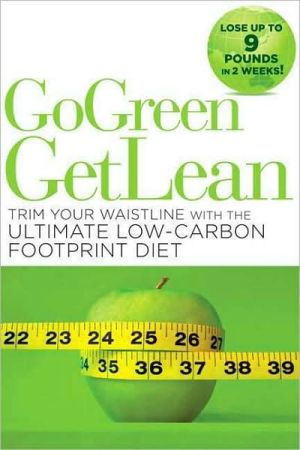Go Green Get Lean: Trim Your Waistline with the Ultimate Low-Carbon Footprint Diet
Over the past 20 years America has been steadily marching toward a diet that is more drenched in fossil fuel than any key nutrient. Experts estimate that it now takes roughly 7 to 10 calories of fossil fuel energy to bring one calorie of food energy to the American plate. Not only have our eating habits turned us into an increasingly overweight society, but the alarming truth is that our food choices are having as much of an impact on the planet as the cars we drive.\ Go Green Get Lean is the...
Search in google:
Over the past 20 years America has been steadily marching toward a diet that is more drenched in fossil fuel than any key nutrient. Experts estimate that it now takes roughly 7 to 10 calories of fossil fuel energy to bring one calorie of food energy to the American plate. Not only have our eating habits turned us into an increasingly overweight society, but the alarming truth is that our food choices are having as much of an impact on the planet as the cars we drive. Go Green Get Lean is the perfect eating plan for our time. Revealing easy-to-follow steps anyone can take to eat for a healthy body and planet—and drop up to 9 pounds in the first 2 weeks—Kate Geagan helps readers see the questionable value of “convenience” foods, and explains why going green doesn't require a drastic vegan overhaul. Because there are many nutritional benefits to be drawn from some non-plant-based food choices, she points readers to the best selections, including occasional splurges they can enjoy in good conscience. In learning to make truly LEAN choices, Kate offers the following straightforward formula: Before eating food, ask yourself: Local or global? What was the Energy used to bring it to my plate? (Include processing, packaging, transportation, and temperature of food.) Animal or plant? (Plant foods are greener.) Is this Necessary? (Is this food critical to my health and weight goals?) This trailblazing work—the first to offer a specific weight-loss plan along with the promise of a lowered carbon footprint—makes it possible for readers to help the environment and their waistlines at the same time. Publishers Weekly Comparing a consumption-heavy lifestyle to a gas-guzzling SUV, Geagan arms readers with a dense but readable treatise on making healthier choices for body and planet. Over the course of six weeks, readers are encouraged to adopt a "flexitarian" diet, heavy on plants with limited amounts of fish, meat and chicken. In a week-by-week fashion, Geagan illustrates the benefits of greener consumption habits with straightforward, relevant data-not only do readers learn the benefits of adding more water to their diet, they also learn the fastest way to shrink their carbon footprint is eliminating bottled water-though she may alienate some with her presumption that we're all on the same sociopolitical page. Geagan keeps an impressive amount of research manageable with anecdotes, charts and digressions covering milk myths (it does not in fact help you lose weight); the fresh-frozen-or-canned debate; and requisite dining out tips. The already-converted and those sincerely interested in change should find this a valuable resource, but McMansion-dwelling, SUV-driving convenience-food junkies should prepare for a harsh talking-down to. Copyright © Reed Business Information, a division of Reed Elsevier Inc. All rights reserved.
Introduction xiii1 Types of Innovation 1Several Types on Many FrontsIncremental and Radical Innovation 2Factors That Favor Incremental Innovation 7Process Innovations 9The Product-Process Connection 10Service Innovations 11Summing Up 122 Idea Generation 15Innovation's Starting PointNew Knowledge 16Customer Ideas 18Learning from Lead Users 21Empathetic Design 23Invention Factories and Skunkworks 26Open Market Innovation 32The Role of Mental Preparation 34How Management Can Encourage Idea Generation 36Four Idea-Generating Techniques 41Summing Up 473 Recognizing Opportunities 49Innovator as EntrepreneurA Method for Opportunity Recognition 52Rough Cut Business Evaluation 55Summing Up 584 From Recognition to Support 61Gaining a FootholdThe Champion 63Supporting Cast 63Get the Timing Right 66Build a Business Case 67Line Up Stakeholders 69Maintain Momentum 72Summing Up 735 Early Tests of Business Potential 75Stage-Gates and Quick KillsThe Idea Funnel 76Stage-Gates 79A Caution on Funnels and Stage-Gates 82Financial Issues 83Discovery-Driven Planning 91The R-W-W Method 92Summing Up 956 Types of Strategy 97Which Fits Your Business?Low-Cost Leadership 99Differentiation 105Customer Relationship 107The Network Effect 110Summing Up 1137 Strategic Moves 115Mechanisms for Market Entry and DominanceGaining a Market Beachhead 116Market Entry Through Process Innovation 118Market Entry Through Product Differentiation 119Create and Dominate a New Market 121Extending Innovation Through Platforms 123Summing Up 1258 The S-Curve and ItsStrategic Lessons 127What Curve Are You On?The S-Curve Explained 128Three Lessons 132Limits to These Lessons 138Summing Up 1399 Finding the Future 141Your Next MoveWhere Do You Stand Now? 143Signals That Change Is in the Making 144Create a Welcoming Home for the Future 147Summing Up 14810 Placing Strategic Bets 151The Portfolio ApproachPortfolio Management 153Getting a Handle on Risk 156Bottom-Up or Top-Down Innovation? 159Summing Up 16011 Human Creativity 163The Starting Point of InnovationMyths About Creativity 165Three Components of Individual Creativity 167Managing for Greater Individual Creativity 170Summing Up 17412 Working Through Creative Groups 175The Power of NumbersCharacteristics of Creative Groups 176Conflict in Groups-and How to Handle It 184Time Pressure and Group Creativity 186Finding the Right Balance in Group Tenure 187Summing Up 19013 Toward a Creativity-Friendly Workplace 193Practical StepsRisk Taking Is Acceptable to Management 196New Ideas and New Ways of Doing Things Are Welcome 197People Communicate Freely 198Knowledge Is Shared 200Good Ideas Find Supportive Executive Patrons 201Innovators Are Rewarded 202The Physical Surroundings Bring People Together 203How Friendly to Creativity Is Your Workplace? 206Summing Up 20914 Leaders Can Make a Difference 211It's in Their HandsFixing the Culture 212Establish Strategic Direction 214Be Involved with Innovation 217Be Open but Skeptical 219Improve the Idea-to-Commercialization Process 220Exercise Flexibility 221Don't Overlook Innovations in Processes, Finance, and Distribution 222Put People with the Right Stuff in Charge 223Create an Ambidextrous Organization 223Summing Up 225Appendix A: Writing a Business Plan 227Appendix B: Workplace Assessment Checklist 237Notes 241Glossary 249For Further Reading 255Index 261About the Subject Adviser 271About the Writer 272
\ Publishers WeeklyComparing a consumption-heavy lifestyle to a gas-guzzling SUV, Geagan arms readers with a dense but readable treatise on making healthier choices for body and planet. Over the course of six weeks, readers are encouraged to adopt a "flexitarian" diet, heavy on plants with limited amounts of fish, meat and chicken. In a week-by-week fashion, Geagan illustrates the benefits of greener consumption habits with straightforward, relevant data-not only do readers learn the benefits of adding more water to their diet, they also learn the fastest way to shrink their carbon footprint is eliminating bottled water-though she may alienate some with her presumption that we're all on the same sociopolitical page. Geagan keeps an impressive amount of research manageable with anecdotes, charts and digressions covering milk myths (it does not in fact help you lose weight); the fresh-frozen-or-canned debate; and requisite dining out tips. The already-converted and those sincerely interested in change should find this a valuable resource, but McMansion-dwelling, SUV-driving convenience-food junkies should prepare for a harsh talking-down to. \ Copyright © Reed Business Information, a division of Reed Elsevier Inc. All rights reserved.\ \








